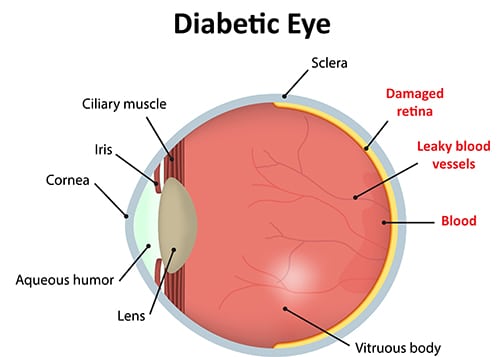Diabetic Retinopathy
Diabetes can cause the vessels in the eye that supply blood to the retina to swell or shrink, affecting vision. This is a progressive disease called Diabetic Retinopathy.
Both eyes are usually affected, but the changes can be so small in the early stages of Diabetic Retinopathy that they may not be noticed. As the disease progresses, it can cause irreversible vision loss. Other symptoms include:
- Blurred vision
- Vision that changes between blurry and clear
- Floaters (dark irregular shapes floating in your field of vision)
- Blank areas in your field of vision
- Bad night vision
- Colors that look different or less vivid
- Loss of vision


What Causes Diabetic Retinopathy?
Consistently high blood sugar levels, such as those associated with diabetes, can damage the small blood vessels that supply blood to the retina, causing them to swell.
This inflammation sometimes causes the vessels to leak blood or fluid. Other times, the swelling can cause them to close off completely, which can stimulate the growth of new irregular vessels, which in turn can cause damage to the retina.
How Common Is Diabetic Retinopathy?


Anyone with diabetes, or who is at risk for developing diabetes, is also at risk for developing Diabetic Retinopathy.
But there are other factors, some that are within your control, that play a role in determining whether you develop Diabetic Retinopathy, or to what degree. Those factors include:
- Your blood sugar level; keeping it under control is a key factor.
- Your blood pressure; maintaining a healthy level lowers your risk.
- How long you have diabetes; eighty percent or more of people with diabetes will develop Diabetic Retinopathy after 15 years.
- Your cholesterol and triglyceride levels; maintaining healthy levels also lowers risk.
- Your ethnicity; African Americans, Latinos and Native Americans are more likely to have diabetes.
- Pregnancy; having diabetes and getting pregnant increases your risk.
How Is Diabetic Retinopathy Treated?
Because vision loss caused by Diabetic Retinopathy is often irreversible, prevention is the best option. You can significantly reduce your long-term risk of vision loss by maintaining careful control of your blood sugar levels.
The treatments that are available won’t cure Diabetic Retinopathy or restore your lost vision, but they may slow down its progression, and minimize vision loss. Left untreated, the disease will continue to progress.
Laser surgery can shrink abnormal vessel growth and reduce swelling. A special contact lens is placed on the eye to focus the laser on the vessels accurately.
Vitrectomy surgery uses a special operating microscope and tiny surgical instruments to remove blood and scar tissue from the eye manually. This allows more light to pass through the eye and focus on the retina.
In some cases, medication that reduces the growth of abnormal blood vessels may be injected directly into the eye to slow down the progress of the disease. The medication can also help reduce swelling and leakage, which may improve vision.
